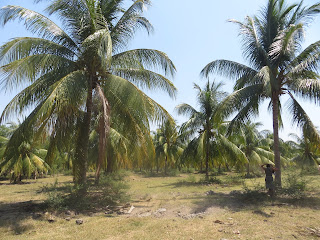This community has quite the story. In 1980, a group of about 400 people, most from Chalatenango, the area up north where I was last weekend, had to go into hiding or be killed by the military during the war. The 'Earthquake Core Plan' as I believe our speaker called it, was a strategy from the military base nearby to to just wipe out literally everyone in the campo to flush out resistance. This included women and children. So the group fled to San Salvador with the help of the 4 religious women from the US who are very famous down here. They hid in a church basement for a few months and then many of them journeyed to Nicaragua, where they lived in a refugee camp for 8 months.
On April 15, 1990 during a Bible study tge women read a passage in Jeremiah that talks about God returning the people to their home. They took this to heart as a sign. In order to get back, they had to pressure the government to give them passage. They rejected offers for passage for one family at a time and demanded that they all be able to go together. They occupied the embassy until it was granted. They aroused the interest of many different countries in the process and continue to rally foreign support today.
Once back in El Salvador, they were granted land that previously belonged to one of the elite families. With this land, they have built an incredible community. They grow corn, sugarcane, and coconut enough to feed the community and hold profits from selling sugarcane communally to benefit social projects in the community. After seeing the success and ideas of these people, they have received aid or support on specific initiatives or buildings from 'their Canadian brothers', the Dutch, England, scholarships from Spain, solar panels from Pittsburg, septic tanks from the UN, a health care clinic from Cuba and El Salvador's National University, Sweden, Puerto Rico, and Japan. They have schools that surrounding communities attend, a bookstore, a church, a community center, dance classes, music classes, a soccer team (and pick up games daily where I was welcomed!), and each family has a home. Decisions are made through community wide voting and a council that included women and men from the start oversees the community.
This community is incredibly progressive. The environmental and social sustainability seen here is phenomenal, particularly considering they built it from the ground up in the last 20 years. Their standard of living is still incredibly modest and It is not to say that they are not struggling. However, it was very inspiring to see how they are working to overcome the unspeakable things they saw and experienced during the war and create such wonderful opportunities for the next generation as well as serve as a model for surrounding communities. It is also encouraging to see how they are clearly developing, but are doing so in a way that is Salvadoran, rather than following a US or European development model, socially and economically. Currently, one of their biggest struggles is the start of the transition of handing the responsibilities of maintaining and improving the work of the community to this next generation. This is a huge task, because many young people aren't excited about working the land and want to seek other job options. I hope to keep up with the progress of this community to see how they deal with these coming challenges.
The community keeps their history alive through art. Here are some of the many murals found around the pueblo as well as some photos from our tour of their fields.
 |
| Coconut trees! They said they don't really profit much from them, but they feel committed to using part of their land to keep the trees and give back to the environment. |
 |
| Agropastorialism- take notes, everyone! |
 |
| We got to try some sugercane! |
 |
 |
| This mural on the church depicts their personal exodus story. |
 |
| They've even got some solar panels. |
 |
| This depicts their relations with the "German brothers". |
 |
| This was part of my host family's corn crop. |



No comments:
Post a Comment